Basic Electronics
Harvard University
All 26 results
Sort by
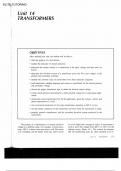
-
Transformers
- Class notes • 24 pages • 2024
-
- $10.49
- + learn more
Transformers are electrical devices that transfer electrical energy between circuits through electromagnetic induction. They consist of primary and secondary windings around a magnetic core, allowing voltage levels to be stepped up or down efficiently. Essential in power distribution, transformers enable the safe and efficient transmission of electricity over long distances, minimizing energy loss. Their ability to adjust voltage levels makes them crucial for various applications, from household...

-
The Engineer And Society
- Summary • 7 pages • 2024
-
- $7.99
- + learn more
Engineers play a pivotal role in society by applying scientific principles to develop innovative solutions to real-world problems. They design infrastructure, improve technology, and ensure safety and efficiency in various industries. By addressing societal needs, engineers contribute to economic growth, enhance quality of life, and drive sustainable development. Their work not only shapes the modern world but also anticipates future challenges, making engineers essential for societal progress a...

-
Series RLC Circuits
- Summary • 7 pages • 2024
-
- $6.39
- + learn more
A series RLC circuit comprises a resistor (R), inductor (L), and capacitor (C) connected in a single path. The circuit's impedance depends on the frequency, with a characteristic resonance frequency where the inductive and capacitive reactances cancel each other. At resonance, the impedance is purely resistive, and the circuit can either attenuate or amplify signals. Series RLC circuits are crucial in applications like tuning, filtering, and signal processing in electrical and electronic system...

-
Parallel RLC Circuit
- Summary • 9 pages • 2024
-
- $7.99
- + learn more
A parallel RLC circuit consists of a resistor (R), inductor (L), and capacitor (C) connected in parallel. It exhibits complex impedance behavior, combining resistive, inductive, and capacitive effects. The circuit's total impedance varies with frequency, leading to resonant behavior at a particular frequency where inductive and capacitive reactances cancel out. This makes parallel RLC circuits vital in tuning and filtering applications within communication and signal processing systems.

-
LENZ, Transformer and Faraday Law
- Summary • 9 pages • 2024
-
- $5.49
- + learn more
Lenz's Law, Faraday's Law, and transformers are foundational concepts in electromagnetism. Faraday's Law states that a changing magnetic field induces an electromotive force (EMF) in a conductor. Lenz's Law extends this, stating the induced EMF opposes the change causing it. Transformers, based on these laws, transfer electrical energy between circuits through electromagnetic induction, efficiently altering voltage levels in power systems, making them crucial in electrical distribution and u...
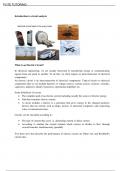
-
Introduction to Circuits
- Summary • 12 pages • 2024
-
- $8.49
- + learn more
Introduction to circuits explores the basic principles and components of electrical systems. It involves understanding elements such as resistors, capacitors, inductors, and power sources, and how they connect to form a functional circuit. Key concepts include voltage, current, resistance, and the application of Ohm's and Kirchhoff's laws. Learning about circuits is essential for designing, analyzing, and troubleshooting electrical and electronic devices, forming the foundation for advanced en...
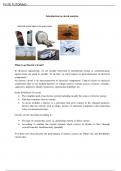
-
INTRODUCTION TO CIRCUIT ANALYSIS
- Summary • 10 pages • 2024
-
- $3.99
- + learn more
Introduction to circuit analysis involves understanding how electrical circuits function by examining the relationships between current, voltage, and resistance. Key concepts include Ohm's Law, Kirchhoff's Voltage and Current Laws, and the use of techniques like mesh and nodal analysis. Circuit analysis is fundamental for designing, troubleshooting, and optimizing electrical systems, providing the foundation for advanced study and practical application in various electrical and electronic engi...
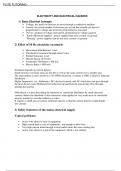
-
ELECTRICITY AND ELECTRICAL HAZARDS
- Summary • 1 pages • 2024
-
- $2.99
- + learn more
Electricity powers countless devices and systems but poses significant hazards. Electrical hazards include shock, burns, and fires caused by exposure to live wires, faulty equipment, or improper handling. Understanding these dangers and implementing safety measures is essential to prevent injuries and ensure safe usage of electrical systems and appliances.
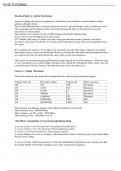
-
Electrical Safety
- Summary • 3 pages • 2024
-
- $2.99
- + learn more
Electrical safety is crucial for electricians to prevent accidents, injuries, and fatalities. It involves adhering to proper protocols, using personal protective equipment, and ensuring circuits are de-energized before work. Awareness and compliance with safety standards protect both workers and the integrity of electrical systems, ensuring reliable and secure operations.
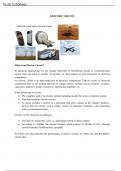
-
ELECTRIC CIRCUIT
- Summary • 10 pages • 2024
-
- $7.99
- + learn more
An electric circuit is a closed loop that allows current to flow through various components, such as resistors, capacitors, and transistors. It comprises a power source, conductors, and loads. Circuits are fundamental to powering devices and systems, enabling controlled electrical energy flow and functionality in various applications.

Do you wonder why so many students wear nice clothes, have money to spare and enjoy tons of free time? Well, they sell on Stuvia! Imagine your study notes being downloaded a dozen times for $15 each. Every. Single. Day. Discover all about earning on Stuvia


